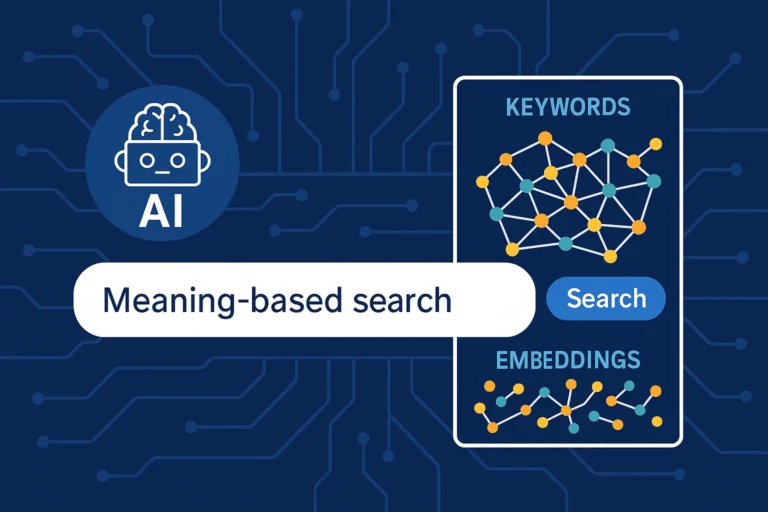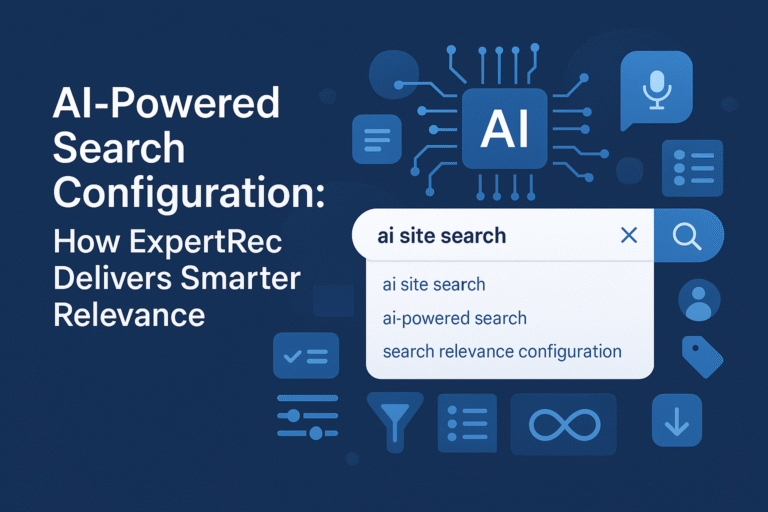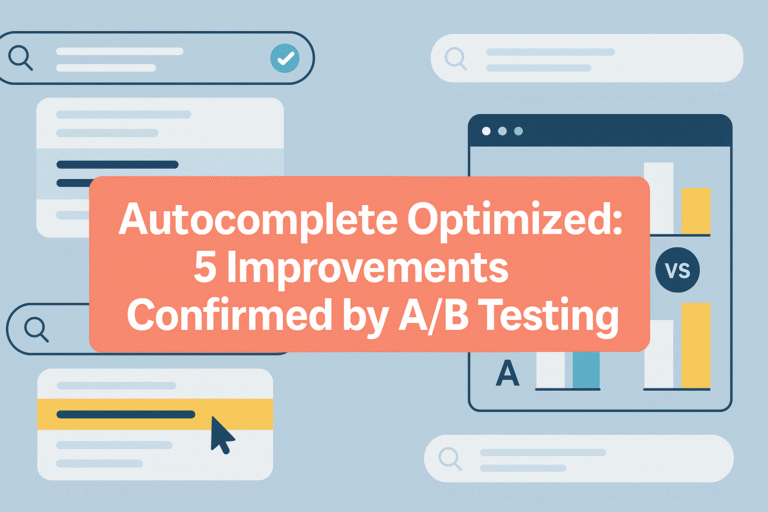As user expectations evolve, traditional keyword-based search is no longer sufficient. Today’s digital consumers expect accurate, relevant, and personalized search results even when their queries are vague, imprecise, or in natural language. This is where embedding-based search transforms the landscape. By representing words, phrases, or entire documents as high-dimensional vectors, this approach allows machines to understand and retrieve semantically relevant content not just exact matches.
In ecommerce, media, knowledge bases, and enterprise systems, embedding-based search is driving a new era of intelligent discovery. This blog explores how it works, its benefits, whether it’s worth adopting, and how Expertrec makes implementation easier for businesses of all sizes.
What Is Embedding-Based Search?
Embedding-based search replaces exact word matching with semantic similarity, allowing a system to return results that are conceptually related to a user’s query even if they don’t share the same keywords.
At the core of this method are embeddings, which are vector representations of data (text, image, audio, etc.) in a continuous, high-dimensional space. These embeddings are generated using deep learning models such as Word2Vec, BERT, or Sentence Transformers.
Example:
-
A user searches for “laptop for students.”
-
A traditional search might only match listings with the exact phrase.
-
An embedding-based search, however, understands that “budget notebook” or “affordable MacBook” might be equally relevant, even if they don’t contain those exact words.
How Embedding-Based Search Works
Step 1: Text Embedding Generation
Queries and documents (e.g., product titles, descriptions, FAQs) are passed through a pre-trained or fine-tuned language model that converts them into dense vectors.
Step 2: Vector Storage and Indexing
These vectors are stored in a vector database (like FAISS, Pinecone, or Vespa) that supports fast similarity searches using algorithms like approximate nearest neighbors (ANN).
Step 3: Query Vector Comparison
When a user enters a query, it is also converted into a vector. The system computes the cosine similarity or Euclidean distance between this query vector and stored vectors to find the most relevant matches.
Step 4: Ranking and Retrieval
The most similar items are returned and ranked based on semantic closeness, relevance, or business logic.
Advantages of Embedding-Based Search
Embedding-based search enables far more powerful and flexible retrieval than traditional methods.
1. Semantic Understanding
It can match the meaning of a query, not just its literal words, making it highly effective for natural language queries.
2. Multilingual and Cross-Domain Capabilities
Embedding models trained on multiple languages allow cross-lingual search. A query in Spanish can retrieve relevant English documents based on meaning.
3. Robust to Typos and Synonyms
Because it relies on context, the system can still return relevant results even if the query contains misspellings, abbreviations, or uncommon synonyms.
4. Context-Aware Ranking
Embedding-based systems can factor in semantic relevance, personalization, and intent classification to improve rankings and user satisfaction.
5. Unified Search Across Modalities
Embeddings aren’t limited to text. They can also represent images, audio, or structured data—enabling unified, multimodal search systems.
Is Embedding-Based Search Worth Using?
Absolutely Especially for Use Cases That Require:
-
Semantic search (e.g., ecommerce, support portals, academic databases)
-
Personalized content recommendation
-
AI chatbots and conversational agents
-
Knowledge base search or document retrieval
-
Multilingual user support
However, it’s important to evaluate your specific needs and technical readiness.
Pros:
-
Highly relevant search results, even for complex or long-tail queries
-
Future-ready (integrates well with AI assistants, voice search, etc.)
-
Supports scaling across languages and content types
Cons:
-
Requires GPU or specialized hardware for training and inference
-
Embedding generation and vector indexing add computational cost
-
Integration with traditional systems may need engineering resources
For businesses without in-house ML teams, building and maintaining an embedding-based search pipeline can be complex. That’s where platforms like Expertrec offer a strategic advantage.
Alternatives to Embedding-Based Search
Before committing to embedding-based search, it’s helpful to compare it with other popular search methodologies:
| Search Method | Core Strengths | Limitations |
|---|---|---|
| Keyword Search | Fast, simple, easy to set up | Can’t interpret meaning or handle synonyms |
| Faceted Search | Useful for structured navigation | Relies heavily on manual filtering |
| Semantic Search | Combines traditional and contextual data | Can be less precise without vector embeddings |
| Embedding Search | Understands intent, context, meaning | Higher resource and implementation complexity |
While traditional methods still serve a purpose in well-structured catalogs or metadata-rich sites, embedding-based search clearly leads when handling natural language and user-intent-driven interactions.
How Expertrec Simplifies Embedding-Based Search Implementation
Embedding-based systems can seem intimidating, especially for ecommerce teams focused on results, not infrastructure. Expertrec bridges that gap by offering:
1. Out-of-the-Box Embedding Pipelines
Expertrec integrates advanced vectorization models without requiring customers to train or host them. You get the benefits of embeddings without the DevOps burden.
2. High-Performance Vector Indexing
Powered by optimized ANN algorithms, Expertrec’s vector engine ensures sub-second latency even for large catalogs.
3. Hybrid Ranking Algorithms
Expertrec intelligently blends traditional keyword scoring with vector-based relevance for optimal accuracy and speed.
4. Visual UI Integration
Search boxes, auto-suggestions, and result grids can be customized and embedded easily via no-code tools or low-code APIs.
5. Ecommerce Personalization
Embedding search is enhanced using clickstream data and product metadata to personalize results in real time maximizing conversions.
6. Scalability
Whether your store has 1,000 or 1 million SKUs, Expertrec’s infrastructure handles search volume with elastic scalability.
Final Verdict
Embedding-based search isn’t just a buzzword it’s a game-changing approach that redefines how users interact with content. Whether you’re managing a product catalog, digital knowledge base, or customer support portal, embedding-based techniques improve discovery, engagement, and conversion.
Yet, building such a system from scratch takes time, resources, and machine learning expertise. That’s where Expertrec delivers real value offering an embedding-powered, scalable search engine with minimal setup and maximum performance.
If your business is ready to embrace the next generation of intelligent search, Expertrec provides the tools and support you need to succeed without the engineering burden.
FAQs
An embedding is a high-dimensional vector that captures the meaning of a word, sentence, or document, allowing machines to perform semantic comparisons between queries and content.
2. How is embedding-based search different from traditional search?
Unlike keyword-based search, embedding-based search retrieves results based on meaning and context, not just exact word matches.
3. Does embedding-based search require machine learning expertise?
Not necessarily. With platforms like Expertrec, businesses can leverage embedding-based search without managing ML pipelines or infrastructure.
4. Can Expertrec support hybrid search (keyword + embedding)?
Yes. Expertrec supports hybrid search models that combine the speed of keyword matching with the intelligence of vector-based relevance scoring.
5. Is embedding-based search suitable for ecommerce?
Absolutely. It’s ideal for product discovery, long-tail queries, typo tolerance, and personalized search experiences.
6. How scalable is Expertrec’s vector-based search?
Expertrec is built to scale. Whether your catalog is small or extensive, the system delivers fast, relevant results even at large query volumes.




